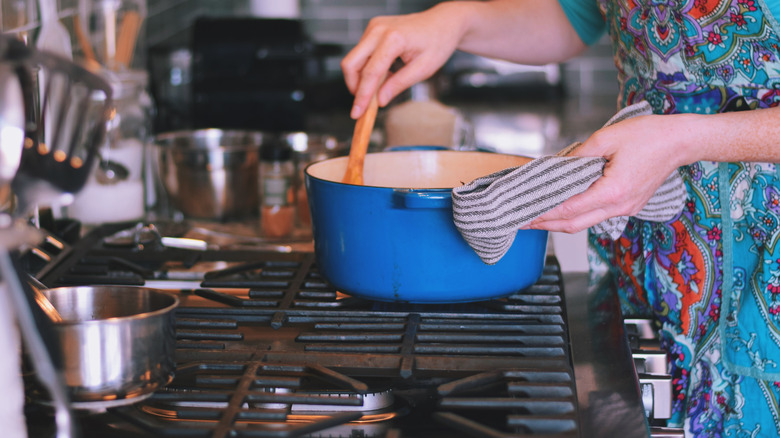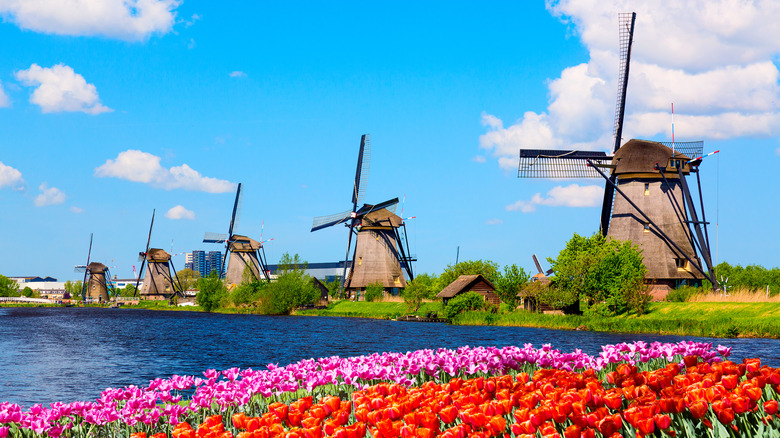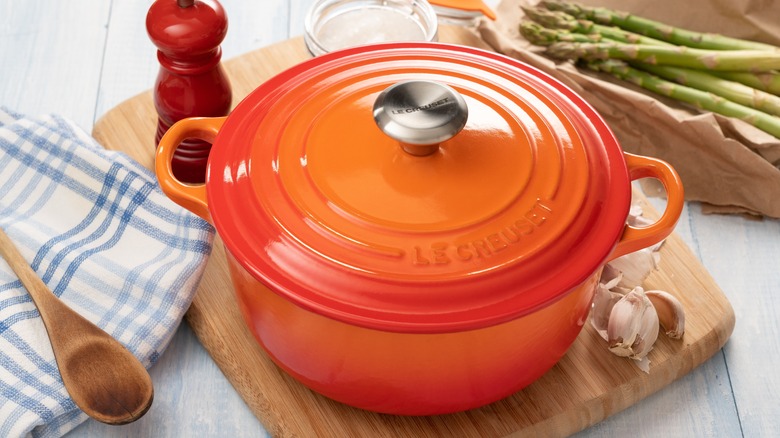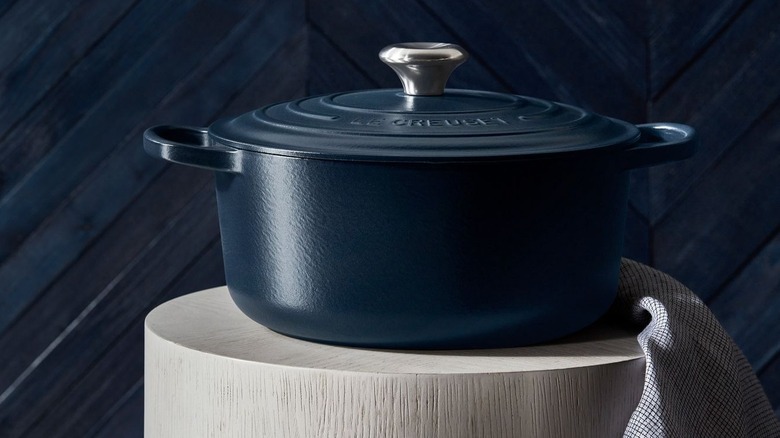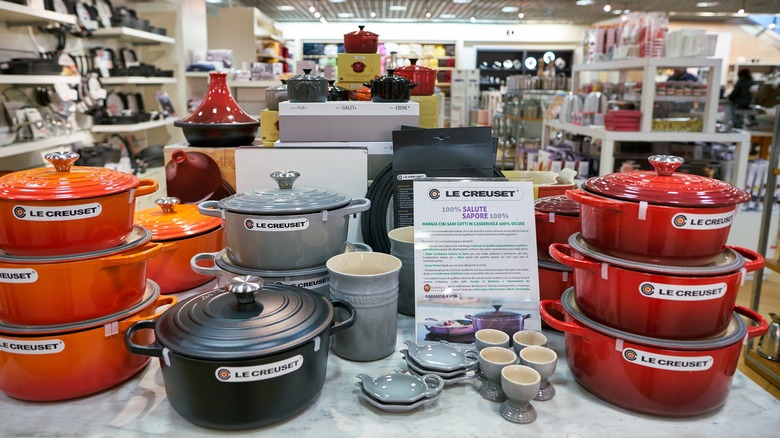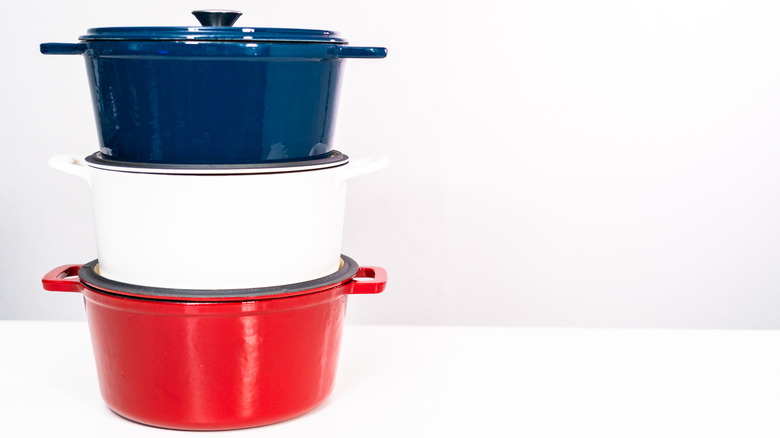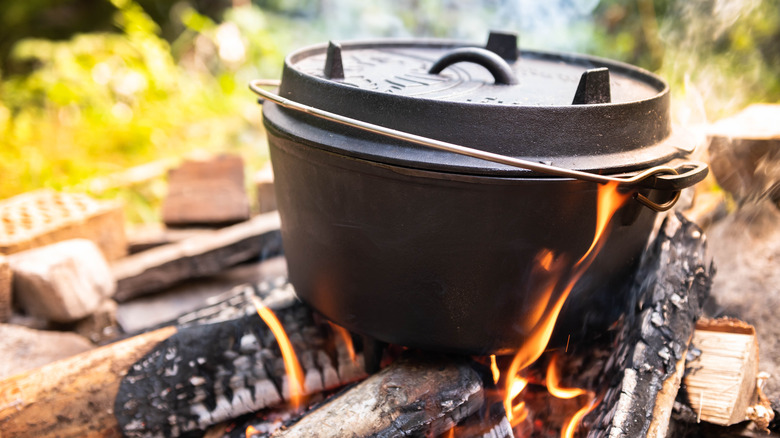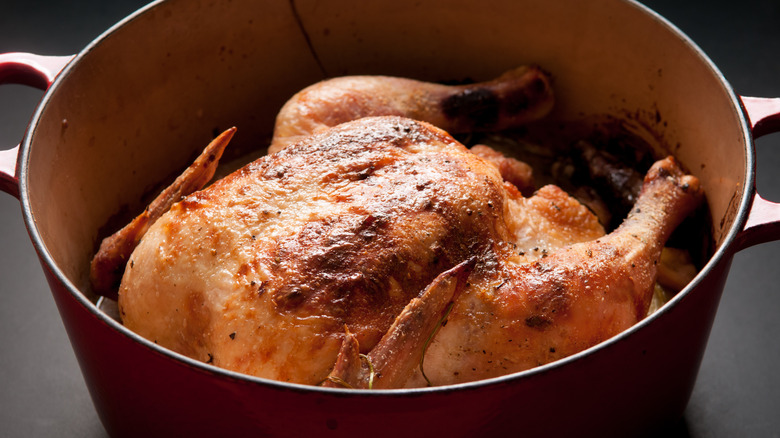Everything You Need To Know About Dutch Vs. French Ovens
For many kitchens, the Dutch oven is considered the pièce de résistance. Fans of the old-world cookware have nothing but praise for it. They note that it can cover just about any cooking task from braising, to making some choice sourdough and pasta, and even frying. There's very little that Dutch ovens can't do: They have a high heat threshold that leaves them at home on the stovetop or in the oven, work fantastically for slow cooking, and some designs even make for excellent presentations themselves.
But, you can't talk about Dutch ovens without bringing up French ovens. Brands like Le Creuset and Staub have made a major splash in the luxury cooking market, and ardent fans are mostly willing to pay top dollar for a piece. At first glance, it's confusing, as Dutch ovens tackle just about all the same tasks as a French one, yet differ in price and sometimes appearance. However, there are some differences between the two. Read below to find out all there is to know about Dutch and French ovens, including what they have in common and what makes them unique.
The Dutch oven has a cross-cultural history
As the name suggests, Dutch ovens originate from the Netherlands, at least partially. In the 17th century, the Netherlands was experiencing what some historians have referred to as a "Golden Age," as it became a major trading power, economic center, and flourished both in science and art.
No exception to the general abundance, Dutch pots were regarded as high-quality goods that were traditionally made with either brass or copper. Of course, these tools weren't called Dutch ovens by the Dutch, but rather braadpans or sudderpans, and they were typically used to roast and simmer food.
But, the modern Dutch oven, at least the way we know it, really got its design in England. One economical innovator, Abraham Darby, was impressed with Dutch pots on his trip to the Netherlands in the early 18th century. The casting process favored by Dutch craft people was highly refined and left the pots smooth in a way that English ceramics at the time weren't.
Darby studied the Dutch casting process and used it on cast iron, which was much more affordable than the expensive metals favored by the Dutch. By 1707, the cast iron Dutch oven was patented and soon became a major part of cooking.
Dutch ovens were a large part of Early American history
When Europeans immigrated to the Americas, they brought their beloved pots with them. Even Christopher Columbus is said to have had Dutch ovens on board with him on his first voyage to the Americas in 1492. But, it wasn't that ovens' high quality that brought them overseas, as they were very much necessary for survival.
Dutch ovens were rugged and durable cookware that could survive a transatlantic voyages and treks across the continent. It's said that on Lewis and Clark's legendary journey across the States, a Dutch oven was packed along with their other tools. Indigenous communities across the continental Americas had similar cookware, albeit made from clay rather than iron. Nonetheless, a little bit of trade would happen as communities with different cookware came into contact.
In the colonial kitchen, Dutch ovens held an incomparable place, where they were used to create many early U.S. meals. The States put their own twist on the staple cookware and added some major changes to the design. None other than Paul Revere is credited with adding three legs and a tighter lid to the pot, both of which helped food cook more evenly. At the time in Early American history, the cookware was often so important that people left them in their wills! Mary Bell Washington, mother of George Washington, did so upon her passing.
French ovens differentiated themselves with enamel
Le Creuset is a true game changer that elevated the Dutch oven market in 1925 with its porcelain enameled cast iron pots. The company was founded in 1924 in the region of Aisne, France,, where sand, iron, and other raw materials were available in abundance. The Belgian co-creators, Armand Desaegher and Octave Aubecq, were experts in casting and enameling respectively.
Together, they were able to take Dutch ovens to the next level with a cast iron oven with an enamel coating. The two-layers of enamel coating are chip-resistant, work as a fantastic heat conductor, and can be washed easily with soap. Not to mention, the coating typically comes in beautiful colors and designs that have become synonymous with the brand.
It is perhaps Le Creuset that was able to coin the term "French oven," after all the unique enameling was in fact first done in France. However, that term has become a bit more muddied, given that there are now Dutch ovens that are enameled as well. So, in a sense, French ovens can be understood as a certain style of Dutch oven, where French companies still dominate the specific design.
French oven designs are unique and handmade to this day
France is known for prizing the locational specialty of its products, after all, Champagne famously only comes from the Champagne region! Likewise, ardent fans of brands like Le Creuset and Staub, may argue that both companies' France-based foundries contribute to the French ovens' high quality. Both brands remain very much rooted in their point of origin, with Le Creuset even still operating out of its OG foundry. This means that the quality, if not the materials, of the French oven has roughly stayed the same over the last century. Additionally, Le Creuset is still handmade with the precision and artistry that has become equated with French goods. It seems like the French oven isn't only a tool, it's a philosophy.
But, the French oven, specifically Le Creuset, also ushered in one-of-a-kind design. The French company created a unique sand mold, that is broken down and re-formed after each use. A secret mixture of irons is poured into the mold, and then sanded, deburred, polished, and coated in enamel. There's a lot of work that goes into make each individual Le Creuset French oven!
French ovens have been marketed to be a luxury good
Perhaps the arduous artisanal process behind French oven brands like Le Creuset is partially why the cookware is seen as a luxury good. Most would laugh off the idea of spending hundreds and hundreds of dollars on a kitchen tool, but those who love Le Creuset are absolutely adamant that the price is worth it.
Some, like Sara Bir (via Paper Magazine), assert that while the term "French oven" might be mired in some Francophilism, the ovens remain iconic staples of the modern kitchen. The once-retailer recounted her time working for a cookware retail store with a certain festive fondness. Starting in November, Le Creuset pans would begin flying off the shelves in time for the holidays. She believed this happened not only because of the French brand's stunning visual aesthetic, which involves both bold colors and playful shapes, but also because of larger values tied to brands like Le Creuset. She equates the brand as an encouragement to cook more slowly, mindfully, and complexly.
Moreover, Le Creuset itself has done much to market the French oven as a luxury good. After all, the appeal of Dutch ovens, originally, were their affordability. But, while Le Creuset is intentionally marketed as a luxury good, the oven's handmade process that goes under inspection 15 times also contributes to the tool's two-digit price tag.
There are many finishes to choose from now
While Le Creuset may have been the first to use enameling on its ovens, it certainly wasn't the last. Nowadays, any number of brands, French or not, choose to add an enamel coating to their ovens. Dutch ovens are now sold in one of two ways: In its OG material of pure cast iron or enameled with either a cast iron or ceramic base. Both designs are veritable workhorses, and it really comes down to a matter of taste as to which one to buy. Some people prize enamel Dutch ovens for the wide range of colors that they are available in, while others aren't as pleased and say that they don't heat as evenly as cast iron.
But, there may be a new finish that's earning some footing in the French and Dutch oven world: aluminum! As trendy as aluminum Dutch ovens sound, aluminum casting dates as far back as the 19th century. It wasn't until the 20th century however, as electric stoves began gaining popularity, that aluminum Dutch ovens really began taking off. Perhaps, an exciting future awaits them!
When camping, bring a Dutch oven
When heading out for a weekend of camping, it may be best to leave the more fragile enamel Dutch ovens at home, where they can remain safe in the kitchen. Cast iron can be a bit more rough and tumble and is quite durable and scratch resistant. Not only that, but cast iron does exceptionally well on an open-flame, and will heat without cracking due to the material used to make it.
Cast iron pots can even be stacked upon one another to cook multiple dishes at once. While we may not always think of the campsite as a place of haute cuisine, there can certainly be some yummy eating around the bonfire! Interesting to think that long ago, those journeying West in the United States brought their cast iron pots with them to eat on the road, and nowadays, some campers might just do the same. The only thing to keep in mind, is that cast iron is quite heavy, and will certainly contribute to the weight of your bags while traveling.
Both specialize in different foods and require different care
The terms Dutch and French ovens tend to overlap, but do have their specific cooking and care tips to keep in mind. For simplicity's sake, we will use Dutch to refer to cast iron ovens and French to enamel.
Dutch ovens are well-seasoned and heat evenly: More sensitive dishes that require time and/or precision like Dutch babies and roast chicken are some of its specialities. Slow-simmered wine or tomato sauces, however, are inadvisable as their acidity risks damaging the oven's seasoning.
Slow-cooked fish dishes on the other hand can potentially add unwanted flavor into the oven's seasoning. While the pots can be re-seasoned afterward, it's best to avoid the problem altogether and use something else! When it comes to cleaning, a little scrubbing with a soft sponge and water will do the trick. The Dutch oven must be properly dried so that it doesn't rust, and re-seasoning with a bit of cooking oil afterward is a must.
French ovens can cook a much wider range of food, as their enamel coating prevents them from absorbing flavors. However, French ovens also need to be oiled up, so food doesn't stick — usually a thin layer will do the trick. It's wise to immediately drain the oven of oil after cooking to avoid the risk of it seeping into the enamel. Afterward, clean your French oven with soap, but, do make sure to use a soft sponge to avoid scratching the enamel.
